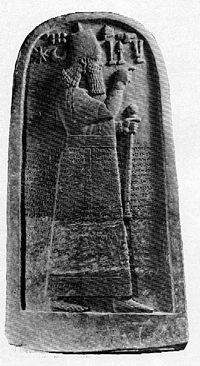Adad-nirari III
Adad-nirari III or Ramman-nirari III (871-r. 856-828 BC) was a king of Assyria during the days of the Neo-Assyrian Empire. During his reign, he attempted to restore Assyria to its former glory, but was not successful. His immediate successor is believed to have presided over a profound religious and social upheaval on account of the continuing weakness of the Assyrian nation-state.
Accession
Adad-nirari III succeeded his father, Shamshi-Adad V, when he was still a minor. His Babylonian mother Shammuramat[1] or Shemiram (often confused with Semiramis)[2] ruled as regent for five years. Therefore he is assumed to have been born in 871 BC, on the theory that the age of majority for a king in that region was twenty years.
Military campaigns
When he came of age, Adad-nirari began planning military campaigns to recover some of the strength that Assyria had lost during the troubled times of his two predecessors, Shamshi-Adad and Shalmaneser III. The most important of these was a siege of Damascus in 848 BC, during the reign of King Hazael (or perhaps Ben-hadad III) of Syria.[3][4] The Quartz Hill School of Theology has a page[5] quoting this inscription from Adad-nirari's stele:
| “ | Against Aram [i.e., Syria] I marched. Mari', king of Aram, in Damascus his royal city, I shut up. The terrifying splendor of Assur ...overwhelmed him and he laid hold of my feet, he became my vassal. 2300 talents of silver, 20 talents of gold, 3000 talents of copper, 5000 talents of iron, colored woolen and linen garments, an ivory bed, an ivory couch...his property and his goods, in immeasurable quantity, in Damascus, his royal city, in his palace, I received. | ” |
Biblical synchrony
The term Mari' (literally, "my lord") refers either to Hazael or to Ben-hadad III of Syria, whom Adad-nirari III stopped from completely destroying the Kingdom of Israel during the reign of Jehoahaz, son of Jehu.(2_Kings 13:5 )
After the death of Jehoahaz, Joash of Israel attacked Syria three times, winning each time. Yet on the Stele of Tell al-Rimah,[6] Adad-nirari boasts of receiving a tribute from Joash of Israel. This payment, if it was made, might or might not have to do with any of Adad-nirari's campaigns. But the account of that tribute might not be accurate, for this reason: Assyria grew weaker toward the end of Adad-nirari's reign, and this weakening continued after his death.
Death and succession
The death of Adad-nirari marks the beginning of the 45-year hiatus in the Eponym Canon. (The ending is the accession of Shalmaneser IV.) Three years into this hiatus came the death of Joash of Israel and the accession of Jeroboam II—which the Bible synchronizes with the career of the prophet Jonah, who visited another unnamed Assyrian king—undoubtedly Adad-nirari's forgotten successor.
Adad-nirari III Born: Born:: 871 BC Died: Died:: 828 BC
| ||
| Preceded by Successor of::Shamshi-Adad V |
King of Ruler of::Assyria Accession::856 BC–Died::828 BC |
UnknownNext known title holder:Succeeded by::Shalmaneser IV |
References
- ↑ "Adad-nirari III." Encyclopædia Britannica. 2010. Encyclopædia Britannica Online. 19 Jul. 2010 <http://www.britannica.com/EBchecked/topic/4900/Adad-nirari-III>.
- ↑ Entry for "Assyrian civilization." All About Turkey, accessed July 19, 2010. <http://www.allaboutturkey.com/asur.htm>
- ↑ "Biblical archaeology regarding the divided kingdom of Israel and Judah," Biblical Archaeology, accessed July 19, 2010. <http://www.truthnet.org/Biblicalarcheology/10/Dividedkingdom.htm>
- ↑ Wikipedia:Adad-nirari III by Wikipedia
- ↑ Entry for "Israel and the Assyrians," Quartz Hill School of Theology, accessed July 19, 2010. <http://www.theology.edu/lec20.htm>
- ↑ "What is the significance of Iraq in the Bible?", Christian Answers, accessed July 19, 2010. <http://www.christiananswers.net/q-abr/abr-iraq.html>
